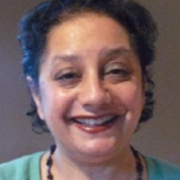
Jayashree Panjabi
English-born Jayashree Panjabi arrived in New Zealand with her family, at the age of 14. After gaining a BA in History with first class honours at Otago University, Panjabi joined the presenting team on pre-school show Play School in 1980. At the time she was meant to be writing a social history of early maternity care, but the experience of working part-time on Play School saw her shift into the world of television.
After two years Panjabi returned to university — this time in Auckland — to complete a Post Graduate Diploma in Broadcast Communication.
From 1983 until 1991 she worked as a director and producer at TVNZ. Her first directorial credit was in 1983 for early home renovation show The Renovators. Panjabi also directed for Play School, children’s show Spot On and science show Fast Forward.
Panjabi was also developing her talent for documentary making. Her 1988 doco Philippine Affair — about a Kiwi setting off to meet his 'mail order bride' — was named one of the 10 best documentaries of the decade, at the 1990 Hawaii International Film Festival. The following year prime time breast cancer doco Fragile Futures won a gold medal at an Italian film festival devoted to medical and science topics.
In 1991 Panjabi went freelance, winning two bronze awards at American festivals for her cot death doco Pieces in the Puzzle. She produced doco Sex, Power and Birth Control, which won a Certificate of Merit at 1994's WorldFest, a long-running festival in Texas. She also worked as producer on two children's series for Dunedin company Taylormade Productions, and directed items for Sunday morning arts series For Arts Sake.
In 1998 Panjabi joined Otago Museum as the Exhibitions and Community Programmes Manager. In 2000 she moved to Dunedin's Aoraki Polytechnic, as programme co-ordinator of the institution's Television, Theatre and Radio course.
Panjabi returned to television in 2002, this time as a senior producer at Natural History New Zealand. The Dunedin-based company was born in 1978 under the wing of TVNZ, before growing to become the world's second largest producer of wildlife programming.
As Panjabi's China-heavy CV attests, NHNZ has expanded into many other topics and locales, from its natural history beginnings down south. Panjabi directed and produced documentaries about animals, construction and Chinese acrobats, and wrote about mutation and soldiers in Hong Kong. She made programmes for America's Discovery Channel, Animal Planet, and National Geographic, plus Japan's NHK, learning along the way the complex art of creating different versions of a programme for different markets.
Panjabi's first NHNZ production was globetrotting nature series Wild Secrets, in 2002. She also worked extensively for NHNZ's Beijing office, making seven documentaries in China over a five year period. Among them were three Megastructures documentaries that Panjabi wrote, directed and produced, broadcast on National Geographic Channels International. Megastructures: World’s Smart Tower, the last of the trio, chronicles the construction of the 72 story Pearl River Tower, intended as one of the world's most environmentally-friendly skyscrapers.
Her favourite NHNZ production is China Circus (2007). The two-parter follows a group of children training to be elite acrobats in Wuqaio, an area of China with a rich acrobatic history. In 2008 specialist documentary publisher RealScreen choose the first episode 'Elites' as one of its favourite picks, from the hundreds of productions being sold that year at international screen market MIPCOM.
Panjabi left NHNZ in 2010 to go freelance. One of her first gigs was in Australia, as a post-production producer on the seventh series of long-running National Geographic show Taboo.
In 2012 she left television to work in education. After almost six years as an Enterprise Manager at Otago University, Panjabi moved to Victoria University, where she leads a team seeking potential sources of research funding.
Profile updated on 1 July 2020
Sources include
Jayashree Panjabi
Anonymous, ‘Made in China’ (broken link) NHNZ Website. Accessed 27 October 2012